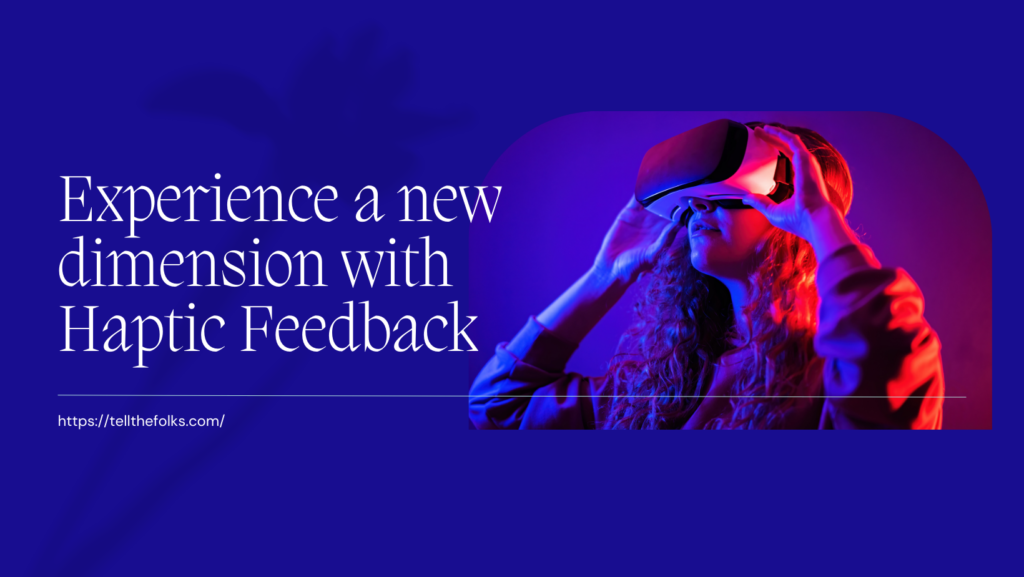
When it comes to user interfaces and design, touch hasn’t been in the spotlight lately. We’ve been mesmerized by colourful graphics for ages, but guess what’s changing the game? Yup, haptic feedback! This blog post dives into why haptic feedback is a big deal, how it’s changing user experience in various fields, and why it’s here to stay.
Introduction to Haptic Feedback
What is Haptic Feedback?
Haptic feedback, or tactile feedback, is like a secret language of touch between you and your device. Imagine feeling vibrations, movements, or forces that bring a whole new level of interaction to devices like smartphones, wearables, and gaming controllers. This tech doesn’t just respond, it communicates with you physically, making your digital world feel more alive, intuitive, and immersive.
A Brief History and Evolution
The term “haptic” originates from the Greek word “haptikos,” meaning “related to the sense of touch.” The world of haptic technology has deeper roots than we realize, tracing back to the 1950s and 60s when initial versions of sensory feedback enhanced joysticks and other interfaces. Initially basic, feedback was mechanical with buzzing sounds and motorized motions. Now, in the era of cutting-edge smartphones and gaming consoles, advanced actuators craft immersive, detailed sensations.
What is Haptic Feedback on iPhone
Apple catalyzed the popularization of haptic feedback with its “Taptic Engine,” first introduced with the iPhone 6S. This engine allows the user to feel a subtle vibration when they perform different tasks on their device, such as scrolling, unlocking, or receiving notifications. The Taptic Engine uses a linear resonant actuator to produce these precise and varied responses, setting a new standard for what haptic touch can be.
User interfaces and design have long been captivated by vibrant visuals, leaving touch somewhat overlooked. However, the spotlight is shifting towards haptic feedback, shaking things up in the game!
Types of Haptic Feedback
Tactile Feedback
Tactile feedback is the most common type of haptic feedback and typically relates to the sense of touch and motion. This is what users would feel, for example, when typing on a smartphone keyboard or when playing a racing game where they may ‘feel’ the road beneath the tires.
Force Feedback
Force feedback, on the other hand, is a more dynamic and robust form of haptic feedback. It can simulate resistance, pressure, and weight. This is particularly useful in applications where the user is interacting with objects that have physical properties, such as in a virtual surgery or a fighter plane simulation in gaming.
The Distinction Between the Two Types
Tactile feedback aims to enhance user interaction with immediate and subtle sensations. Force feedback further solidifies the object’s presence and the user’s interaction with it. Both are pivotal in their respective uses and often complement each other for a comprehensive haptic experience.
Technologies Behind Haptic Feedback
Technologies Behind Haptic Feedback
Actuators are the components responsible for altering energy into motion and are the workhorses behind haptic systems. Common actuators include eccentric rotating mass motors, linear resonant actuators, and piezoelectric actuators, each suited for different types of haptic feedback.
Haptic feedback involves employing sophisticated design and engineering techniques to offer tactile responses to electronic device users, simulating physical interaction with the interface. The goal is to enhance user experience by fostering a more immersive and intuitive interaction between people and technology.
Also Read Augmented Reality Scope and Benefits
Software That Drives Haptic Signals
However, it’s not just hardware at play. The software driving the actuators is equally important. It interprets commands from the applications and generates the appropriate haptic signals that result in the ‘touch’ experience for the user.
Applications of Haptic Feedback
Gaming and Entertainment
In the gaming world, haptic technology has found particularly fertile ground. From console controllers that vibrate during intense gameplay to virtual reality headsets that track your physical movement, haptics make games more engaging and realistic. Furthermore, haptics enhance cinematic and music experiences, bridging the gap between the audience and the creators.
Medical Training and Simulation
Haptics are invaluable in the medical field. In training and virtual simulations, they allow students to practice complex surgeries, sense tissue density changes, and replicate the fine motor skills required for real-life procedures, all without putting a real patient at risk.
Automotive Industry Insights
Haptic feedback is reshaping how we interact with vehicles. In car infotainment systems and dashboards, users experience feedback that mimics the ‘depression’ of buttons or the sliding of a digital screen. This not only enables drivers to keep their eyes on the road but also provides a more intuitive and safer driving experience.
Virtual and Augmented Reality Enhancements
Both VR and AR strive to create immersive environments, and haptics are essential in making that immersion truly profound. From holding a device and feeling the ‘recoil’ of a shot in a game to touching a virtual object and feeling its shape and texture, haptics address the missing sensory link in these experiences.
Benefits of Haptic Feedback
Enhanced User Experience
The primary benefit of haptic technology is in improving and deepening the user experience. By adding the sense of touch to the equation, interaction becomes more engaging, intuitive, and – when done right – almost second nature. This level of immersion is key to customer satisfaction and brand loyalty.
Improved Learning and Training Methods
When it comes to learning new skills or grasping complex concepts, haptics play an important role. By simulating the tactile sensations involved in the task at hand, haptic feedback significantly improves retention and practical application of knowledge.
Increased Safety in Various Applications
In certain industries, especially medical and heavy machinery, haptic technology can be a lifesaver. By providing feedback that alerts users to critical conditions or by simulating dangerous scenarios to train professionals, haptics contribute to safer work environments and better outcomes.
Challenges and Future Directions
Technical Limitations
Haptic technology, although advancing rapidly, still faces challenges in providing truly nuanced feedback. The range of sensations that can be conveyed is expanding, but to achieve truly lifelike interactions remains a work in progress.
Accessibility and Inclusivity Considerations
Designers need to ensure that haptic systems are accessible to users with different abilities and sensory levels. This requires thoughtful and inclusive design principles to avoid inadvertently erecting barriers rather than breaking them down.
Future Trends and Potential Developments
Looking ahead, the future of haptics is incredibly exciting. Innovations are on the horizon that will enable more intricate tactile sensations to be shared, potentially leading to new interactive paradigms and even deeper sensory immersions.
Conclusion
Haptic feedback technology is not just enhancing the way we interact with the digital world; it’s enriching these interactions. From smartphones to virtual environments, the inclusion of touch in user experience design is opening up endless possibilities for businesses and users alike.
The road ahead for haptics is filled with technological advancements and potential applications that can extend its reach. While challenges lie ahead, the potential for revolutionizing UX across industries is immense, paving the way for a new era in human-computer interaction that feels much more human.
Share to
Frequently Asked Questions (FAQ)
Haptic feedback is a technology that creates an experience of touch by applying forces, vibrations, or motions to the user, enhancing the realism of physical interactions in digital environments.
In gaming, haptic feedback is used to simulate physical actions and events, such as explosions, recoil from a gun, or the feeling of driving on different terrains, thereby increasing immersion and engagement.
Yes, haptic feedback can significantly enhance educational and training programs, especially in fields like medicine or mechanics, where it enables students to gain hands-on experience in a controlled, virtual environment.
Related Posts

7 Best Social Media AI Tools in 2024
Explore innovative solutions in latest social media AI tools designed to transform your online presence, streamline content creation, and optimize engagement.

Artificial Intelligence Algorithms
Artificial Intelligence algorithms are the backbone of modern intelligent systems, enabling machines to perform tasks that typically require human intelligence.

Innovations in AI for Education
Discover how Innovations in AI (Artificial Intelligence) is transforming education with personalized learning paths, intelligent tutoring systems, and predictive analytics for enhanced learning experiences.
